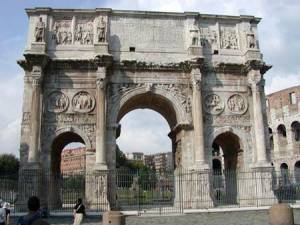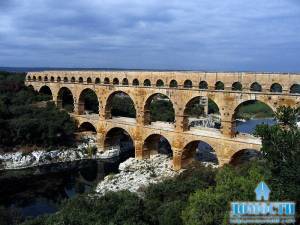 Heir to the artistic culture of Ancient Hellas became a slave Rome conquered Greece in the II. BC. Oe. The Romans, having become acquainted with the mythology, science, literature and theater of ancient Greece, praised the creative genius of the Hellenic architects and sculptors. No wonder the famous Roman poet Horace said that "Greece, taken. captive, captivated by the winners of the wild in the harsh Latsy making art ... ".
Heir to the artistic culture of Ancient Hellas became a slave Rome conquered Greece in the II. BC. Oe. The Romans, having become acquainted with the mythology, science, literature and theater of ancient Greece, praised the creative genius of the Hellenic architects and sculptors. No wonder the famous Roman poet Horace said that "Greece, taken. captive, captivated by the winners of the wild in the harsh Latsy making art ... ".But Rome, the last eight centuries (from VIII to I c. BC. E.) From a small, unremarkable city to the capital of a vast state of the Roman Empire, not only took the best achievements of the Art of the Middle East and the Mediterranean. The Romans contributed to the artistic culture of the ancient world.
Even in the era of the Roman Republic (VI cent. BC. E). Romans built - great roads, bridges and aqueducts, the first was used in the construction of durable and waterproof material - Roman concrete, created and perfected the system of special construction of large public buildings of brick and concrete are widely used along with the Greek architectural orders such form, as an arch, vault and dome.
Under the Ancient Rome meant not only the city of Rome, ancient times but all he conquered the country and the people who made up the colossal Roman power - from the British Isles to Egypt. Roman art - the highest achievement and the result of the development of ancient art. He was created not only the Romans (or Italics), but the ancient Egyptians, Greeks, tires, residents of the Iberian Peninsula, Gaul, Germany and other ancient peoples, subjugated by Rome, sometimes standing on a higher level of cultural development.
Roman art has developed on the basis of a complex interpenetration of original art of local Italic tribes and peoples, especially the powerful Etruscans, the ancient owners of a highly distinctive culture hudozhestnoy. They introduced the Romans to the art of town planning (different sets of options, the Tuscan order, engineering structures, temples and houses, etc.), wall mural painting, sculpture and painted a portrait of a different nature and keen perception of character.
The beginning of Roman art refers to the period of the republic (end VI - I in the middle. BC. E.). It flourished during the formation of the global slave power, diverse ethnic and social composition, a complex of economic and social organization.
With the spread of Roman rule in Greece and the Hellenistic state in Rome, entered the sophistication and luxury of Hellenistic cities. The influx of wealth from the conquered countries in the III-I centuries. BC. Oe. changed the manners of the Romans, giving rise to the ruling classes of waste. Were imported in huge quantities famous Greek statue of Mr. Greek masters paintings. Roman temples, palaces turned into a sort of museum of art.
In the end I c. BC. Oe. The Roman state from an aristocratic republic has turned into the Roman Empire. The first ruler who opened the way for autocracy, was Caesar's grandnephew Octavian, called Augustus (Blessed). Caesar adopted him shortly before his death.
When Octavian proclaimed emperor (27 BC. E.), It meant that he would hand over the supreme military power. Officially, he is still considered one of the senators, while the "first among equals" - emperor. The reign of Octavian, called the Principate of Augustus. Since the beginning of Roman art guided by the ideals that fostered the rulers. Until the end I c. Mr. Oe. two reigning dynasties: the Julio-Claudian and Flavian.
 The so-called "Roman peace" - a lull in the class struggle that has occurred at the beginning of the reign of Augustus, - stimulated the highest flowering of art, the growth of the construction. Ancient historians describe the period of the reign of Augustus (27 BC. E. - 14 AD. E.) As the "golden age" of the Roman state. It is associated with famous names Veptruvpya architect, historian Titus Libya, poets, Virgil, Ovid and Horace.
The so-called "Roman peace" - a lull in the class struggle that has occurred at the beginning of the reign of Augustus, - stimulated the highest flowering of art, the growth of the construction. Ancient historians describe the period of the reign of Augustus (27 BC. E. - 14 AD. E.) As the "golden age" of the Roman state. It is associated with famous names Veptruvpya architect, historian Titus Libya, poets, Virgil, Ovid and Horace.The official focus in art has become "the August Classicism," which had a huge impact on the subsequent development of Western European art. The Roman artists were guided by the great masters of Greece, Phidias times, but the naturalness of the Greek classics was replaced prudence, restraint.
Rome acquired a totally new look that matches the prestige of the capital of the world. Increase in the number of public buildings, built forums, bridges, aqueducts, enriched with an architectural decoration. According to the historian Suetonius, since Rome in August, "adorned, that justice could boast that it took a brick, leaving it marble."
The city struck contemporaries immensity area - not with one hand, he did not have clear boundaries. Its suburbs were lost in the luxury villas Campania. Magnificent buildings, porticos koloshshe, vaulted roofs and decorated gables, richly decorated with pools and fountains interspersed with green trees and avenues.
Already at the first receiver in August will begin to disappear ideality imaginary golden age. A new milestone in the art of the reign of Nero was one of the most insane despots, the Roman throne.
The Emperor Nero has decided to give Rome a new look. He looked at Rome as his personal possession, in which the center was to be his home. By decree of the Emperor were secretly burned a few city blocks, on the spot where the Emperor raised him - the famous Golden House.
High flourishing province experienced. The Roman Empire became a slave empire in the Mediterranean. Rome itself became face of a world power. I and the end of the beginning. The II. Mr. Oe. (During the reign of Trajan, and Flavian) - time to create the grand architectural complexes, structures of large spatial scale.
No wonder that under Hadrian (about 125 g) was established by one of the most spiritual monuments of world architecture. However, Adrian thought he just redid the construction of which began to build Agrippa, son of Augustus. Pantheon - the "temple of all gods" - and now stands at the center of Rome. This is the only monument, not rebuilt or destroyed in the Middle Ages. It is not only something akin to the Romans, the people of ancient times, but all mankind.
By the end of III century in Rome came a temporary remission. Imperial power is partly strengthened, the situation a little bit normal. On all sides the capital of the empire barbarians pressed, and the most important architectural buildings were strong defensive walls, including the special position occupied by the wall of Aurelian.
The Emperor Diocletian, who reigned at the turn of the III-IV centuries, has rarely been in Rome. His residence was the Salon, a town in the eastern Adriatic. Diolektian took an important step towards strengthening the empire, through a series of reforms, strengthening the state bureaucracy and a system of tax collection.
 On the nature of his time eloquently Palace built in the Salon. Surrounded by strong ramparts and towers, with exits to the sea, clearly laid out, it was more like a military camp. However, there were residential buildings, and utility services, and the mausoleum, and the temple, and the park. It was convenient for life: Diocletian voluntarily resigned from power after 20 years in office, even bred there vegetables. Yet in this palace does not feel the same freedom. Is there a particular severity and predestination in the subordination of all parts, near the palaces of the future of the Byzantine emperors.
On the nature of his time eloquently Palace built in the Salon. Surrounded by strong ramparts and towers, with exits to the sea, clearly laid out, it was more like a military camp. However, there were residential buildings, and utility services, and the mausoleum, and the temple, and the park. It was convenient for life: Diocletian voluntarily resigned from power after 20 years in office, even bred there vegetables. Yet in this palace does not feel the same freedom. Is there a particular severity and predestination in the subordination of all parts, near the palaces of the future of the Byzantine emperors.The great empire comes to an end when Constantine sits on the throne, the first emperor, officially convert to Christianity. The ancient religion finally outlived its usefulness. After the recognition of Christianity in 313 AD, the predominant religion of the construction of Christian churches, which form mostly borrowed from the ancient basilica.
Constantine moved the capital of the empire to the east, the former Greek city of Byzantium. He was named the "new Rome", or Constantinople. From here begins the story of their new state - Byzantium. Rome has remained the same over the past two centuries tsenrom the western part of the empire. The same pattern is observed outside of Rome, in Italy and in the provinces. Ancient architecture is a long time will remain valid, but it is, growing in the Middle Ages, it is only tradition.
